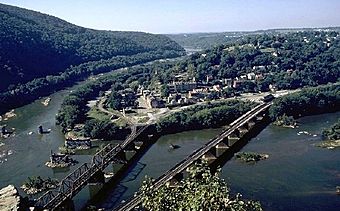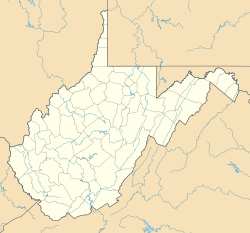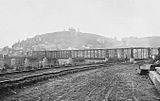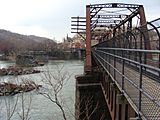- This page was last modified on 17 October 2025, at 10:18. Suggest an edit.
B & O Railroad Potomac River Crossing facts for kids
|
B & O Railroad Potomac River Crossing
|
|

An aerial view looking west. From left to right, you can see the stone piers from the 1851 Bollman bridge, the 1894 bridge, and the 1931 bridge.
|
|
| Location | Harper's Ferry, West Virginia |
|---|---|
| Built | 1839 |
| Architect | Wendel Bollman |
| Demolished | 1936 (flood) |
| NRHP reference No. | 78001484 |
| Added to NRHP | February 14, 1978 |
The Baltimore and Ohio Railroad Crossings at the Potomac River are a group of railroad bridges. They stretch across the Potomac River between Sandy Hook, Maryland, and Harpers Ferry, West Virginia, in the United States. These bridges have a long and interesting history, playing a key role in transportation and even during the American Civil War.
Contents
Building the First Railroad Bridges
The 1851 Bollman Bridge (top) around the 1860s, and its remains next to the 1894 bridge in 2009 (bottom).
Before the railroad bridges, there was a ferry at Harpers Ferry starting in 1733. This ferry was later replaced by a covered road bridge around 1824. This bridge was located where the Potomac and Shenandoah Rivers meet.
The first railroad bridge for the Baltimore and Ohio (B&O) Railroad was built between 1836 and 1837. It was an 830-foot (250 m) long covered wooden bridge. This bridge was the only rail crossing over the Potomac River until after the Civil War.
The bridge had six sections over the river and one section over the Chesapeake and Ohio Canal. Benjamin Henry Latrobe, II designed this single-track bridge. In 1837, the Winchester and Potomac Railroad line reached Harpers Ferry from the south. Latrobe connected this new line to the B&O line using a special "Y" shaped section.
The Bridge and the Civil War
The B&O bridge played a small but important role in history. John Brown, an activist who wanted to end slavery, used the B&O bridge at the start of his attempt to lead a slave uprising in Virginia. This event is known as John Brown's raid on Harpers Ferry.
During the American Civil War, the bridge was destroyed. For a short time, a temporary pontoon bridge was used to cross the river.
New Bridges and a Tunnel
The two main railroad crossings you see today were built much later, in the late 1800s and early 1900s.
The 1894 Bridge
In 1894, a new steel bridge was built. This bridge used a design called a Pratt truss and also had plate girders. It was built for the B&O Valley line, which is now called the CSX Shenandoah Subdivision. This line goes towards Winchester, Virginia, following the Shenandoah River.
At the same time the 1894 bridge was built, a rail tunnel was also constructed. This tunnel goes through an area called Maryland Heights. The tunnel helped the train line avoid a very sharp curve, making the journey smoother.
The 1930-1931 Bridge
Another bridge was added between 1930 and 1931. This was a deck plate girder bridge that carries the main B&O line towards Martinsburg, West Virginia. This line is now known as the CSX Cumberland Subdivision.
During the construction of this second bridge in the 1930s, the western end of the tunnel was made wider. This change allowed for the widest possible curve for trains crossing the river, improving the flow of traffic.






